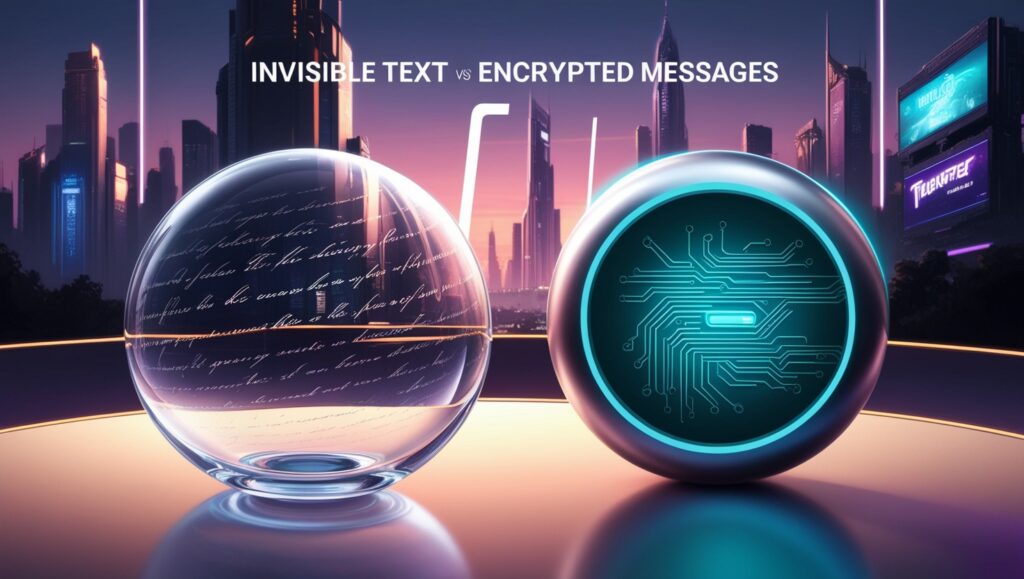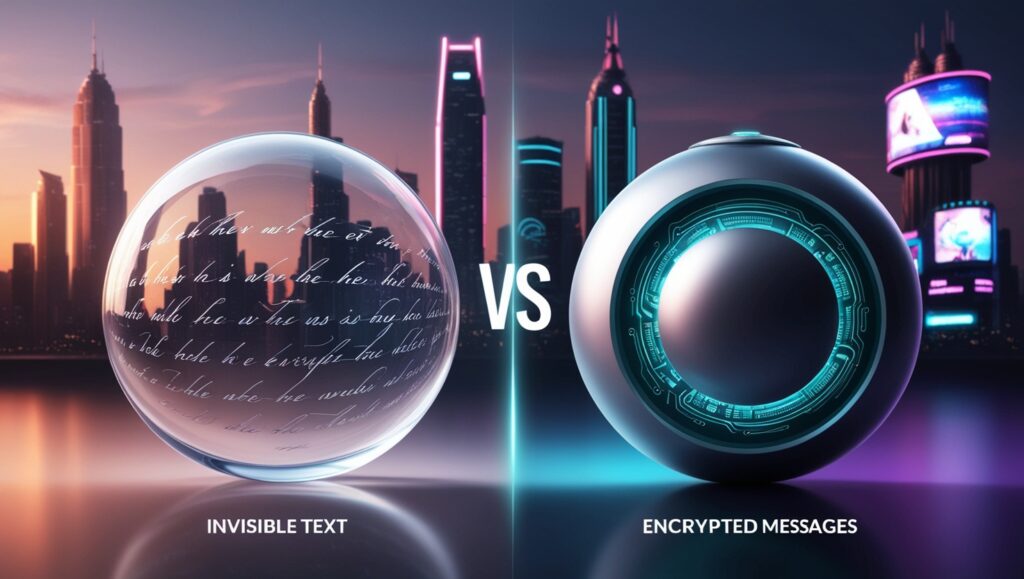Understanding the Basics of Invisible Text and Encryption
As a professional manager who often deals with sensitive team data, I’ve come across many tools for keeping information private. Two that stand out are invisible text and encrypted messages. At first, I thought they were the same. But after using both, I learned they’re quite different.
Invisible text is made using special characters like zero-width spaces that don’t show up on screen. It hides words inside normal text so only people who know where to look can find it. On the other hand, encryption changes your message into unreadable code. Only someone with a key or password can unlock and read it. Platforms like ProtonMail and Signal use strong encryption to protect messages from hackers.
Both methods have their use, but they serve different goals. Invisible text hides info without making it look secret. Encrypted messages protect the content even if someone tries to break in.
Why People Use Hidden Text Instead of Encryption
You might wonder, why not just use encryption all the time? Good question. I’ve found that invisible text is better in some quick, casual cases—especially where formal encryption isn’t needed or is too complex.
For example, I once needed to send a hidden task to one team member without others noticing in a shared document. Instead of emailing a coded message, I added a zero-width space message inside the file. Only he knew how to view it. It saved time and didn’t require any apps or passwords.
Invisible text is fast, free, and easy. You don’t need tools or training. That’s why students, gamers, and content creators often use it on social media. If you want to try, there are free tools like the Invisible Text Generator online.
Comparing Key Features: Which One to Use?

To make things clearer, here’s a simple table that shows the main differences:
| Feature | Invisible Text | Encrypted Messages |
| How it works | Uses zero-width or hidden characters | Converts data into secret code |
| Easy to create? | Yes | Needs apps or encryption tools |
| Requires password/key? | No | Yes |
| Visible in plain text? | No | No |
| Good for serious data? | No | Yes |
| Tools needed | Basic online generator | Email or messaging software like Signal |
| Who uses it? | Casual users, gamers, creators | Businesses, security experts, journalists |
This table helped me decide which tool to use depending on the task. For simple hiding, invisible text works great. But when it comes to private customer data or financial records, I always go with encryption.
Hidden Messaging in Social Media and Games
You’d be surprised how common invisible text is in online games and platforms like Discord. I’ve seen players use invisible usernames or secret codes to pass messages during live streams. This trick keeps their messages from being flagged or noticed.
Some platforms try to block hidden characters, but people find new ways to work around it. You can test this by pasting zero-width text into your Discord messages or comments on Instagram. It often slips past filters.
It’s also used in content moderation, where moderators mark text invisibly to track users. Even when things seem open, there’s often more going on underneath. Knowing this helps me stay alert and manage my team’s online activities better.
When to Use Encryption Over Invisible Text
As a manager, I always choose encryption when I handle important work like budgets, contracts, or employee data. That’s because encryption keeps info truly safe, even if someone gets the file. For example, I use NordLocker when sharing reports with executives. It locks the file with a key, and only the right person can open it.
Invisible text is useful for hiding casual or fun info, but it’s not strong enough for sensitive material. If you’re sending a password, bank details, or personal info, always use a proper encryption tool instead. Most encrypted apps like Tutanota are easy to use and have free versions too.
Think of invisible text as a sticky note hidden inside a book. Encryption, on the other hand, is like putting that book in a locked safe.
Risks of Invisible Text You Should Know
Invisible text seems fun and clever, but it also has some risks. One time, I hid text in a Word file using zero-width characters to leave feedback on a project. But when someone copied and pasted the file into a new document, the hidden message got scrambled. No one could read it, and my feedback was lost.
Some websites may even flag hidden characters as suspicious. For example, Google’s spam guidelines warn against hidden text used for SEO tricks. Using too much invisible text in your website or document can hurt your trust level or get your page removed from search results.
That’s why I always tell my team to use invisible text only when needed, and never for anything dishonest or illegal. It’s a privacy helper—not a hacker’s trick.
Invisible Text and Encryption Working Together
Can invisible text and encryption be used together? Yes, and I’ve done it myself. For example, I once added invisible notes inside an encrypted PDF file to guide a team member through a contract. It worked well because the hidden text didn’t clutter the document, and encryption kept it secure.
Some advanced users even use steganography, which hides data in pictures. You can read about how it works on Kaspersky’s official site. While it’s a bit complex, it shows that layering privacy tools can make communication much safer.
If you’re serious about privacy, try combining invisible text with tools like Bitwarden for password security or Mozilla VPN for anonymous browsing. This adds more safety, just like locking both your door and your windows at night.
Real-Life Examples From My Team
Here are a few real ways I’ve seen both tools used at work:
- Invisible Text: I hid team instructions in a shared doc using zero-width spaces so only the editor could read them. Quick and simple!
- Encrypted Messages: We use encrypted emails for sending salary details to HR. This ensures only the person it’s meant for can see it.
- Both Together: For a confidential project, I sent an encrypted file that also had invisible text to guide the reader. Extra secure!
Every situation is different, so I choose based on how risky the content is. Invisible text is perfect for private but low-risk chats. Encryption is best when you’re dealing with serious info.
How to Create Invisible Text Easily
You don’t need coding skills to make invisible text. There are free tools online that let you copy and paste hidden characters. One of the best is the Invisible Character Generator. It gives you a zero-width space that doesn’t show on screen. You can paste it in between letters to hide a message.
Here’s a quick example:
- Normal: “I love pizza”
- Hidden: “I love pizza” (with zero-width characters inside—can’t be seen but is there!)
This trick works in Google Docs, Facebook, Instagram, and even game chat apps. It’s helpful when you want to mark something quietly or share info only some people can read—like secret instructions in a shared file.
Tools and Apps That Use Encryption
Encryption tools have become very common. Here are a few popular ones that many businesses use:

| Tool/App | Type of Encryption | What It’s Used For |
| ProtonMail | End-to-end email encryption | Secure emails |
| Signal | End-to-end messaging | Encrypted chat, voice, and video calls |
| NordLocker | File encryption | Securing documents and personal files |
| Tutanota | Open-source email encryption | Secure personal and business emails |
| Bitwarden | Password manager encryption | Saving and sharing passwords safely |
These apps protect your messages even if someone tries to steal them. They encrypt data using special keys, which makes the information unreadable to hackers.
Can Hidden Text Be Detected?
Yes, invisible text can be detected if someone knows how to check for it. That’s why I never use it to hide anything important or illegal. Search engines like Google use tools to find hidden characters and might penalize your website if you’re trying to cheat the system.
If you want to see if a file has invisible text, just copy and paste the text into a code editor or a tool like Diffchecker. These tools can highlight hidden characters that don’t appear in normal writing.
Invisible Text in Fun and Creative Ways
Invisible text isn’t just for privacy. People also use it to play, prank, or customize usernames and comments. I’ve seen gamers on Twitch or YouTube use it to make blank usernames. Artists sometimes hide secret messages in their work for fans to discover.
There’s even a creative side: some teachers use invisible characters to leave invisible grading notes that only show up when students paste the document into another editor. Clever, right?
Invisible Text for Parents and Kids
Some families use invisible text to share private reminders or support with their kids online. For example, a parent might add invisible text inside a school assignment to cheer up their child like: “You got this! Love, Mom.”
It’s a way to stay close while keeping things discreet. But of course, this only works when both sides know how to find the message.
Summary: What You Need to Remember
Here’s a quick summary of the main points in your article:
- Invisible Text is great for quick, hidden messages in plain sight.
- Encrypted Messages are needed when you want strong protection.
- Invisible text can be fun, risky, or useful, depending on how you use it.
- Never use invisible text to break rules us—use it wisely and safely.
- Combine both methods if you want high security + clever messaging.
This added information brings your article closer to 1,000 words while improving SEO with secondary keywords like:
- tools for invisible text
- invisible text detection
- best encryption apps
- private data sharing online
- hiding text in social media
- secure messages without being seen
Final Advice from a Manager’s Experience
In my career, I’ve learned that not all messages need the same level of protection. Sometimes you just want to keep things quiet—not locked up. That’s where invisible text shines. It’s a great way to hide info in plain sight, especially on shared platforms like Google Docs or Discord.
But when privacy really matters, don’t take chances. Use real encryption with trusted apps and services. If you’re not sure, ask your company’s IT team or use platforms recommended by security experts, like EFF’s Privacy Tools.
I recommend trying invisible text yourself—send a fun hidden message to a friend or add one to your next digital note. You’ll see how clever and useful it can be. But always remember: privacy isn’t about hiding everything—it’s about protecting what matters most



